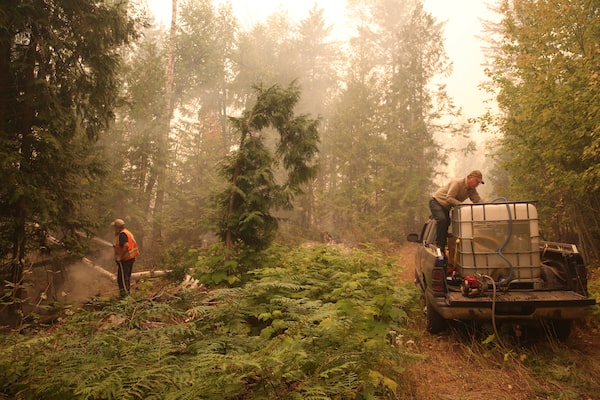
Dean Smith and Everett Loberg Dean and Everett spray water on a fire in Celista, B.C. on Aug. 19.Janis Smith/The Globe and Mail
In the North Shuswap, the marshalling area has always been the Bischoff farm, a property that has stood since 1895. For more than 100 years, the community has looked to the Bischoffs, one of the first non-Indigenous families to settle the valleys north of Shuswap Lake, for leadership. This time, they’re mustering at the log cabin owned by Karl, the patriarch, a logger, champion lumberjack, and former wildland firefighter, to battle one of the biggest and most aggressive fires in British Columbia’s history.
In the kitchen, Karl’s daughter Angela, who runs the Scotch Creek Hub, a restaurant and gym, is hauling roast chickens, beets and potatoes from the oven. She’s feeding a crew of 25. Across the valley, her sister-in-law is cooking for another 20. “At night, women do perimeter checks and spot checking in two-hour shifts so these guys can sleep,” Angela explains. “We only wake the guys if we need to.”
In the driveway, Eric Crawford, 21, is helping Angela’s brother Carson, a fourth-generation logger and champion lumberjack, fill a water tanker from the pond. Both men are covered in soot and sweat, weary from 16-hour days at the fire line. The men are unperturbed and unmoved by orders that they should not be there. None of them are official firefighters, and all have defied evacuation orders, which the province has warned have the force of law.
“It takes a community to save a community,” shouts Mr. Crawford, an electrician, as he climbs into Mr. Bischoff’s white truck. Mr. Crawford doesn’t want to say anything more. He doesn’t have time, he explains – he’s got to get back to the fire.
The Bush Creek East Wildfire – known here as “the monster,” or “the beast” – exploded into North Shuswap, population 2,500, late last week, buffeted by high winds and a back burn lit by the B.C. Wildfire Service last Thursday. In all, 168 structures burned, with 131 of them destroyed completely.
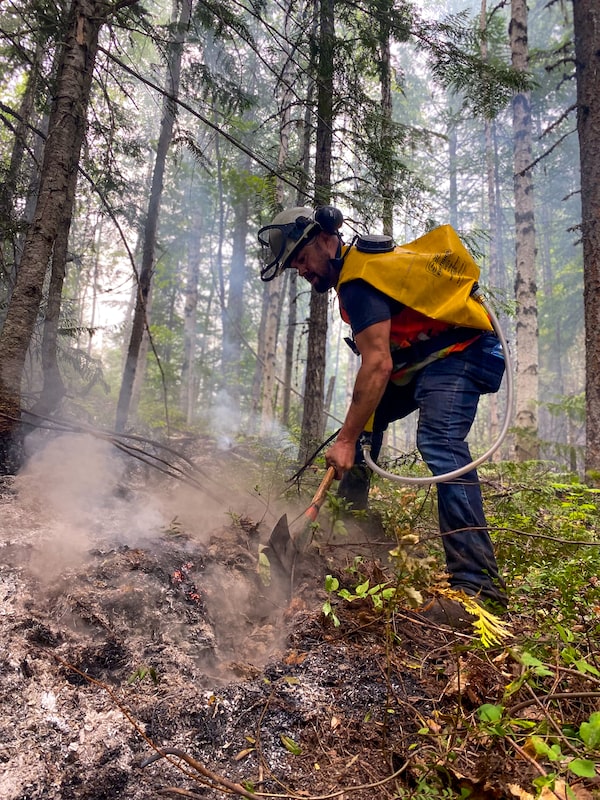
Mark Lagore uses an axe to dig up smoldering ground to keep a fire from flaring up.Nancy Macdonald/The Globe and Mail
“It was like a nuclear bomb went off. You can’t imagine the heat, the noise. It was raining fire. The flames were 400 feet in the air,” says Dave Dyck, who owns a small farm near Celista, a small logging community that swells every summer when lakeside vacationers arrive.
Mr. Dyck could feel the air being sucked from his lungs. Only then did he run. “I had a dump truck with a 3,000-litre fuel water tank and a pump. All night, we were running around, putting spot fires out.”
Efforts like Mr. Dyck’s have been unwelcome by the B.C. Wildfire Service. While Australia relies on about 200,000 volunteers to battle its summer bushfires, B.C. depends on teams flown in from Mexico, Brazil, South Africa and elsewhere in Canada to fight increasingly frequent and violent fires every summer.
Hundreds of international firefighters had to return home earlier this month, forcing B.C. to urgently request more help.
Angela said her community’s portrayal as rogues is all wrong. The men are working furiously, day and night, using their own equipment, their own time, their own money, she said. “Without them, we would have lost everything. That’s the reality.”
“It’s so unfortunate that a crisis like this, we can’t come together,” says her father Karl. “It’s got to be reformed – majorly.”
Minister of Emergency Management, Bowinn Ma says she knows some people want to stay and fight. “I understand that.” But, “evacuation orders must be followed.”
Fire information officer Mike McCulley told a Friday briefing that those who defy evacuation orders to fight the Bush Creek East themselves are not only putting themselves at risk of the flames, but also at risk of getting in the way of aerial firefighting efforts.
“When we have people roaming through our work force, sometimes we have to stop operations because it is just not safe. And when we’re losing ground on containment,” he said. “So it might not seem like a big deal, but when people are underneath our helicopters and we’re trying to work, we have to sometimes stop. And so that can be a really big impact on holding a fire in place.”
Those who have stayed behind in the Shuswap argue reality is different in remote and rural areas, particularly when resources are stretched thin.
During fire season, help is not always readily forthcoming in places with small populations; and officials in B.C. tend to look the other way in rural areas, where residents often need to stay behind to tend to animals they were unable to evacuate, or defend properties.
This was the case in neighbouring Neskonlith last week, where a tight-kit crew of locals had been permitted to stay behind to save a farm belonging to Roy Allgaier from the Bush Creek East fire. And it was the case in the Nicola Valley during the Lytton Creek Wildfire in the summer of 2021, and the Sumas Plain, in Chilliwack and Abbotsford, during the flooding of November, 2021, and the Elephant Hill fire near Ashcroft in 2017.
Defying an evacuation order can impede official firefighting efforts and local residents can be caught in rapidly changing conditions. But residents here argue that when executed properly, a community can be part of the solution.
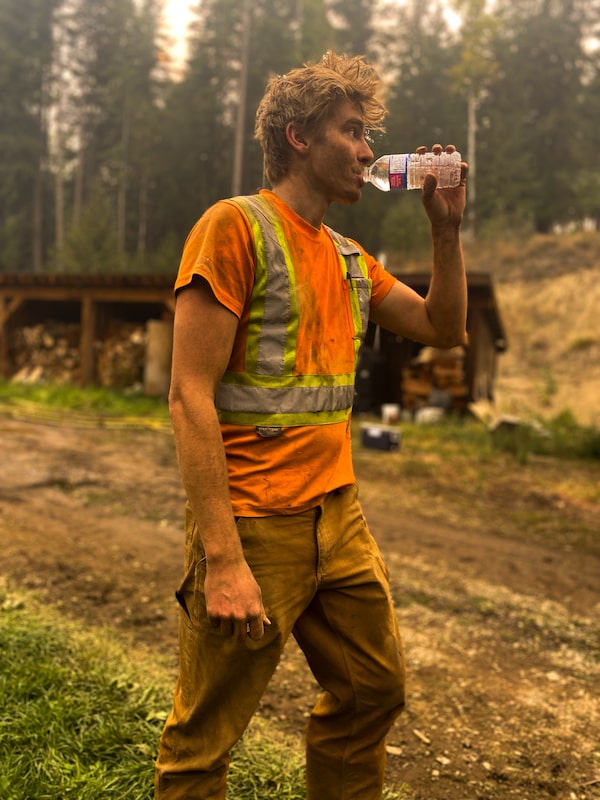
Eric Crawford takes a break from fighting fires near Celista, B.C.Nancy Macdonald/The Globe and Mail
“Look, we all know the risk we’re taking here,” says Danny Payment, whose dock construction business, Queensborough Marine, was the largest business lost in Scotch Creek. “Don’t worry – none of us will be calling WCB,” he adds, referring to workers’ compensation boards.
One of the men who spoke to The Globe dislocated his shoulder fighting the fire. Another burned his forearm after falling into embers. Still another burned his ankle after stepping into an ash pile. All of them kept working.
“We’re not guys with a summer cabin on the lake who decided to stay,” says Jody Evans, a former wildland firefighter and Celista resident. “We’re all experienced.
“We’re out here fighting fires because there is no one else doing it, because we live here, and because it’s the right thing to do. This is nothing against BCWS. They’re stretched so thin. But there are none of them here. None. We were the first responders. There was no other choice.”
Last Friday, howling winds helped the Lower East Adams Lake wildfire merge with the Bush Creek East Wildfire, creating a blaze roughly four times the size of the one threatening West Kelowna. For many in the North Shuswap, calls to evacuate came too late. Some residents had to abandon their cars and huddle on a narrow strip of beach until they could be rescued by boat.
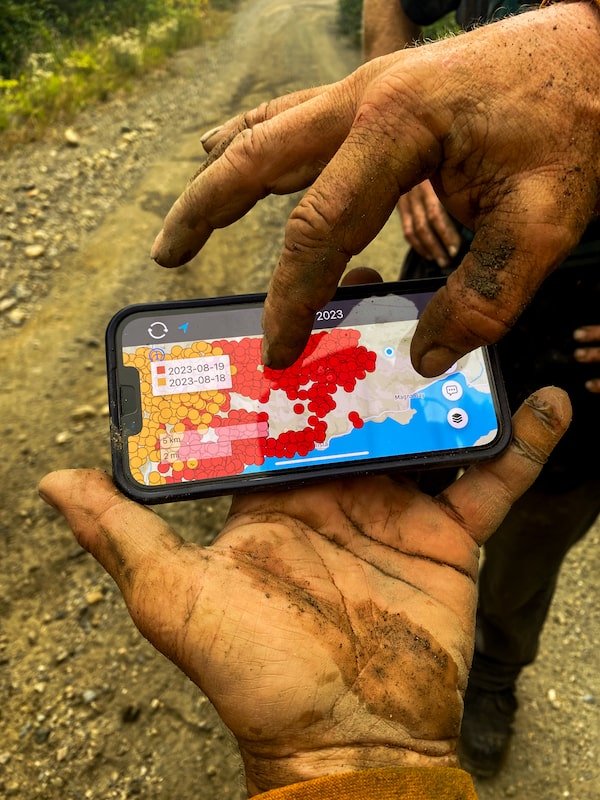
Jody Evans showing a map of the fires approaching his house (the blue dot), northeast of Celista, B.C.Nancy Macdonald/The Globe and Mail
BC Wildfire Service spokesman Forrest Tower acknowledged there were no wildland firefighters in Celista, but 20 were working nearby.
Cliff Chapman, director of wildlife operations, said the planned ignition – the one blamed by many in the North Shuswap for helping to create the inferno – was the right thing to do. “I want to be perfectly clear that planned ignition saved hundreds of homes and properties,” Mr. Chapman said.
But Stephen Moore, a former wildland firefighter who owns a tree removal business, said any structure still standing in Celista and Scotch Creek is because of the work of residents.
People who live in the communities also bring a wealth of knowledge to the table, says Dave Hughes, a mechanic who spent Friday night roaming the bush near Celista looking for spot fires.
“You think I want to be here?” he says. “If there was someone here fighting fires, I’d be off drinking wine, not wrecking my lungs.”
The anger in the Shuswap mirrors that of communities such as Monte Lake in 2021 and south of Francois Lake in 2018. In the face of multiple, challenging wildfires that stretched government resources, residents defied evacuation orders to construct fire guards and soak their properties until the last possible minute, ultimately saving many.
In the aftermath of those fires, community groups self-organized, undertaking government-recognized courses in wildfire suppression and safety, creating call-lists of volunteers and procuring equipment such as water tanks, pumps and hoses. The groups established lines of communication with their local fire centres, expressing their desire to be involved, and what they can offer.
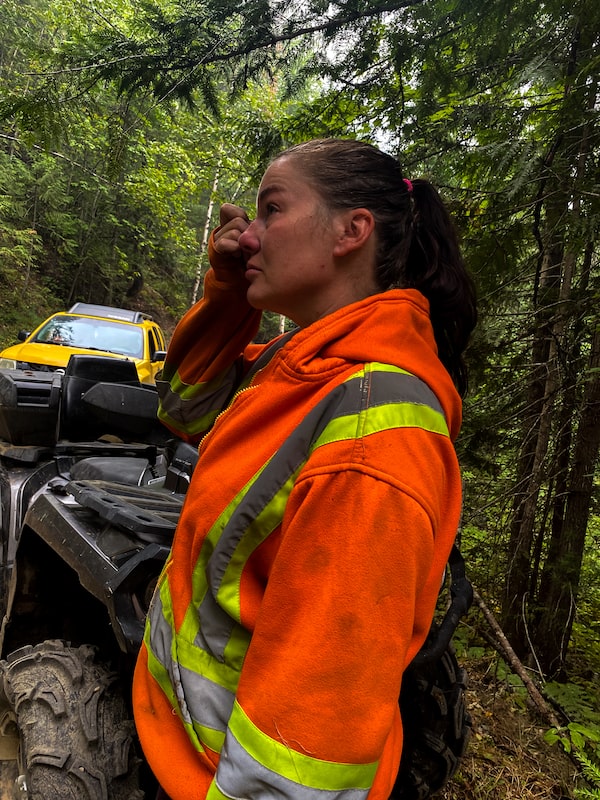
Angela Bischoff and her family have mustered resources to fight wildfires and feed a crew battling blazes in the Scotch Creek, B.C. area.Nancy Macdonald/The Globe and Mail
When wildfire now reaches those communities, the groups work alongside the BC Wildfire Service as contractors, sharing local knowledge of the area, putting out small fires before they grow and assisting with mop-up duties. The arrangement has helped to defuse tensions between government and community.
Mr. Tower said the success of partnerships like these boils down to good communication, advance planning, and basic requirements including minimum-level firefighter training and an organizational structure.
“It is possible, but it does take a little bit of work before there’s a fire,” he said in an interview Thursday. “That little bit of work is very important so that when we’re in a crisis situation, some of that pre-talk has happened in the community and they’re coming to us as a cohesive unit that we can fold in.”
The BC Wildfire Service has started to formalize these partnerships under the Cooperative Community Wildfire Response project. The project, still in its infancy, comprises two streams: One focuses on rural Indigenous communities that may have less capacity to lead a response, and the other on ranchers, loggers and other rural community members who have already self-organized, or are willing to.
Rob Schweitzer, executive director at the BC Wildfire Service, told The Globe in June that the service is aiming to formally identify these groups by the end of the year, after which they still must work through issues of training, liability, and insurance.
“By not [involving them], I would say we risk more of that underground activity, of seeing people do it on their own,” Mr. Schweitzer said. “By recognizing people and groups that have a skill set, an inventory and a bit of training, we can incorporate them – in a minor level, but in a safe manner.”
Mr. Hughes, the Celista mechanic, said he hopes the wildfire service is learning that it can’t stop people from protecting their community.
“They can’t control people the way they’d like. They’re going to have to find a way to work with people in communities. They can’t just let them burn.”
 Nancy Macdonald
Nancy Macdonald Andrea Woo
Andrea Woo